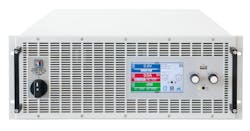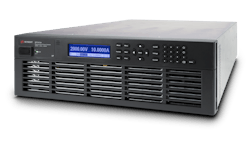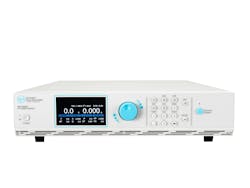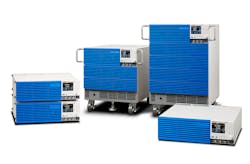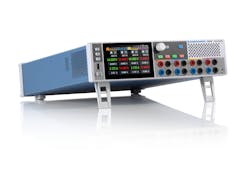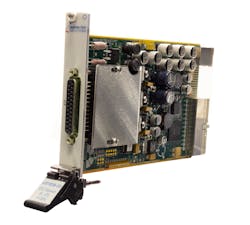Download this article in .PDF format.
Whatever project you are working on, power will be a key aspect. Whether you have a battery powering a mobile device or a wind turbine powering a smart grid, you will need the ability to simulate power sources and the systems they power to make sure the two play well together. Fortunately, vendors offer a variety of programmable power supplies and loads—including regenerative loads—to help you achieve an optimal design. They offer a variety of voltage and power levels, as well as flexible interface options.
EA Elektro-Automatik serves a variety of applications areas, including conventional and electric vehicles, PV and wind energy generation, and energy storage (batteries and fuel cells), according to Zeke Pietsch, applications and customer care manager. He added that the company addresses the test of electronic and electromechanical components including MOSFETs and contactors and that the company’s systems serve in R&D, burn-in production, and electronic manufacturing.
Pietsch said the company leverages SiC high-frequency switching technology as well as the latest FPGAs, microcontrollers, and digital-to-analog converters to develop programmable supplies and loads to serve such applications.
Supplying 10s of kilowatts
EA Elektro-Automatik’s products include the EA-PSB 10000 Series bidirectional programmable power supplies. “The PSB 10000, being bidirectional, fully integrates a high-performance autoranging programmable power supply with a regenerative, programmable electronic load capable of 95% energy recovery,” said Pietsch, adding that the series delivers 30 kW in a 4U chassis with 40-A to 1,000-A and 60-V to 2,000-V ratings. Furthermore, he said, the PSB 10000 also has a hermetically sealed, water-cooled option that dissipates 95% of heat into the water circuit, with only 5% dissipating into the air (conventional losses).
“In addition to the advanced arbitrary waveform generator included, the PSB 10000 comes with battery-simulation software,” Pietsch continued, explaining that many thousands of test data sets for lithium and lead-acid battery testing were created using modeling software to emulate real battery performance in artificial environments for hardware-in-the-loop tests.
For testing commercial string inverters, Keysight offers the PV8921A and PV8922A 20-kW photovoltaic array simulators. “The PV8900 Series offers up to 2,000 V and the ability to test up to 12 MPPT inverters,” Griffith said. “Next-generation inverters increase efficiency and reduce installation costs with higher voltages and multiple MPPT inputs. Keysight’s test solution includes the DG9100 Series advance inverter test software. Application software makes it easier to download PV curves and track measurements.”
Delivering 10s of kilovolt-amperes
Preen AC Power has recently introduced a new AFV+ Series programmable AC power supply, which delivers 10 kVA to 2,000 kVA, said a spokesperson, who added that AFV+ series features low THD, high reliability, multiple programming features, and intuitive operation. “This latest high-power programmable AC power source…can simulate different power-line disturbances and record error logs,” the spokesperson said. “The AFV+ Series can support up to an 840-Hz frequency range that can be used for aircraft, defense, and EV test industries.” The AFV+ Series can output up to 400-V line to neutral or 690-V line to line or, optionally, 600-V line to neutral or 1,039 V line to line.
The spokesperson cited another feature: “In the factory or laboratory, there is often a certain distance in the configuration of power and load. The Remote Voltage Drop Compensation of the AFV+ Series is able to compensate the voltage drop caused by the cable length, so the user can avoid the inconvenience of adjusting the voltage.” The spokesperson also said the AFV+ can test electric motors, which can draw high startup currents. “As a result, users need to purchase a power supply with much higher capacity than the UUT itself,” the spokesperson said, explaining that the AFV+ Series has an optional 200% overload capacity.
“Key features include dual constant-power-mode voltage ranges up to 360 VAC line to neutral or 624 VAC line to line in three-phase mode and an output frequency range from 15 Hz to 1,000 Hz, which is wider than most regenerative AC sources on the market today,” vanEijkelenburg continued. “The use of SiC power devices in all power-conversion stages of the AZX results in higher power density.”
500 VA to 4 kVA at 5 to 1,200 Hz
Nicholas Piotrowski, product manager at Ikonix USA, said Associated Power Technologies, a division of Ikonix USA, is introducing its 8500 Series AC power sources on Sept. 1. The series includes the 500-VA Model 8505, 1.25-kVA Model 8512, 2-kVA Model 8520, and 4-kVA Model 8540. Output voltage extends to 310 VAC with frequencies from 5 to 1,200 Hz. He said the sources cover variety of applications, providing, for example, a 310-VAC output for LED ballasts.
Piotrowski cited a trend toward higher power density (smaller, lighter sources per VA output), noting that sources are often part of a larger system where rack space comes at a premium. “The 8505, 8512, and 8520 all are 2U rack-mountable sources,” he said. “The 8540 is 4U rack-mountable at 62 lbs. That’s a 33% reduction in rack-mount size and 25% reduction in instrument weight from our previous series,” he said.
“We’ve also seen a shift towards more automated transient and waveform synthesis testing,” Piotrowski said. “With automation, giving flexibility to customize programming is key. We’ve moved toward not only offering out-of the-box software (PowerTRAC) but also offering LabVIEW drivers and implementing SCPI protocol on the APT 8500 Series.”
Piotrowski said the company “…implemented a unique modular switching-supply approach…” for its APT 8500 Series. “This allows us to not only offer the advanced features we’ve discussed but also reduce the size and weight of the sources.” He added that the sources can serve in MIL/aerospace, LED, appliance, motor, and medical-test applications and help perform EMC test in accordance with IEC 61000.
Versatile Power has recently released its new 1,500-W RACK programmable power supply, according to Mark C. Brown, manager of sales and marketing. “All Versatile Power supplies come standard with LXI,” he said, adding that other standard features include analog, USB, and Ethernet inputs and wireless remote sense.
Brown continued, “Versatile Power’s BENCH and RACK Series both offer extended range,1 which allows the end user to use one power supply to cover a larger range of voltages and currents, thus reducing the number of units that are need to be purchased for their applications or testing and can be used on cross platform projects that our customers are working on currently or that are in the pipeline.”
He also noted that BENCH and RACK Series products use the 1U footprint while delivering high power. “This allows our customers to be more efferent with their rack space, being that rack real estate is of the utmost importance and giving our customers additional savings,” he said, adding that the products’ digital design contributes to the small formfactor. He also commented, “ATE, burn-in, and avionics are a few of the markets Versatile Power serves.”
New 5,000-W and 3-kVA products
“The MR Series features an LXI-compliant LAN interface and delivers 5,000 W in a compact 2U form factor,” he said. “Furthermore, these power supplies are B&K Precision’s first cTUVus approved instruments, fulfilling equivalent CSA and UL safety standards.”
Fernando described the 9830B Series as a high-performance single-phase AC source delivering output power up to 3,000 VA with low harmonic distortion. The frequency range is 45 to 1200 Hz. “In addition to AC, these models can output DC or AC+DC signals,” he said. Other features include a power meter with 12 measurement functions, built-in and user-defended THD waveforms, and an amplifier mode with a 1.2-kHz bandwidth.
“The 9830B Series programmable AC sources represent our first 3-phase-capable products, Fernando continued. “3-phase is accomplished by using three AC sources connected to small synchronization adapters. The adapters and connecting cables are included in a convenient kit. The synchronized AC signals result in a 3-phase power system. Most specifications and capabilities are maintained with a usable frequency range up to 600 Hz. Positive or negative DC voltage offsets and individual phase control are still available.”
Fernando said B&K Precision’s DC loads are used for testing and evaluating DC sources including DC power supplies, DC/DC converters, and batteries. “The latest 8500B Series is uniquely suited for battery testing applications at a value price point,” he said. “One specific application involves charge/discharge cycle testing where the primary objective is to determine the usable battery life. B&K Precision offers battery charge/discharge software to meet this specific battery testing method. The software combines source capabilities of our 9115 or 9200 Series DC power supplies with the 8500B Series DC loads to evaluate batteries.” Users can log both charge and discharge data, create custom test sequences, and calculate battery capacity using the software, he added.
2-kW supply and 20-kW load
The PLZ-5WH2 is high-voltage (1,000 V) and high-power-capacity (20 kW) load. “Some of the target industries include battery suppliers, high-voltage UPS suppliers, electric-vehicle applications, and any other applications that are in the higher voltage range, up to 1,000 VDC,” the spokesperson said. “We put a lot of work into the built-in measurement capabilities specifically for the use of power-supply test. Integrated measurement, custom sequences, and cutoff settings can all be programmed from the front panel, which make it very powerful as an electronic load and as a standalone power-supply evaluation tool.”
The spokesperson said that in anticipation of its use in battery-testing applications, it features built-in functions to make charge-discharge tests easier for engineers. For example, a cutoff function can automatically shut off the load when meeting a specified Ah, Wh, elapsed-time, or terminal-voltage condition.
400-W and 800-W supply series
Other supplies the company offers, Weigell said, include the R&S NGL200 and R&S NGM200, which enable engineers to analyze and optimize their battery-powered designs, and the R&S NGP800 and the R&S HMP4040, which offer the high channel count and power density to serve applications involving modern high-end FPGAs that demand high power distributed over several lines.
“The specialty power supplies offer two-quadrant architecture: this feature allows them to function both as a source and a sink and simulate batteries or loads,” Weigell said. “The power supply automatically switches from supply mode to load mode. As soon as the externally applied voltage exceeds the set nominal voltage, current flows into the power supply. This is indicated by a negative current reading.”
In addition, the supplies offer galvanically isolated, floating channels. “The Rohde & Schwarz power-supply family consists of instruments with up to four channels,” Weigell said. “The circuitry of each single channel is completely isolated from the others; there is no connection to chassis ground. This makes it easy to combine the channels to drive bipolar circuitries that might need ±12 V, for example, and avoids any ground problems in complex DUTs.”
Power in PXI
Specific products include the GX3104 source-measure unit (SMU) with four isolated, common-ground SMU channels; 4-quadrant operation (±20 V, ±1 A); seven current ranges (±2.5 µA to ±1 A full scale); up to 1-A capability on one channel; and 24-bit ADCs and 18-bit DACs.
The company also offers the GX1838 precision multichannel DC source, which Semancik described as ideal for avionics and high-voltage applications. It features eight high-density discrete outputs, and three programmable voltage rails (14-bit resolution). It offers two output configurations: -10 V to +32 V (GX1838) or -20 V to +20 V (GX1838-20). Maximum current output is 500 mA.
And finally, MTS offers the GX7404 power interface, which features +3.3 V, +5 V, +12 V, and -12 V outputs; software-controlled on/off switching; remote monitoring of voltage and current; an external power-inhibit line; and an on-board prototyping area.
Distributor offerings
Specific products that Newark offers include the GW Instek ASR-2100 compact programmable AC/DC power source, which provides an output rating of 0 to 350 VRMS AC and 0 to ±500 V DC and output capacity of 1,000 VA. “The ASR-2100 Series provides users with waveform output capabilities to meet the test requirements of different electronic component developments, automotive electrical devices, and home appliances,” said Maureen Lipps, product manager, Test & Tools, Newark, adding that the instrument offers three modes: a sequence mode generates waveform fallings, surges, sags, changes, and other abnormal power-line conditions; the arbitrary waveform function allows users to store/upload user-defined waveforms; and the simulate mode imitates power outages, voltage rise and fall, and frequency variations.
Newark also offers the B&K Precision 8514 DC electronic load, which Lipps described as an affordable, laboratory-grade programmable instrument suited for testing and evaluating a variety of DC power sources. “It can operate in CC, CV, CR, or CP mode while voltage/current or resistance/power values are measured and displayed in real time,” she said, adding that the unit is fully programmable via the RS-232 or USB interface and operates between 0 and 120 VDC, 1 mA to 240 A at 1,200 W maximum. A battery testing mode provides the Ah rating of battery.
Newark also offers the MP710259 US 300-W programmable DC load from Multicomp Pro, Newark’s private label brand. Lipps described the MP710259 US as a single-channel programmable DC electronic load designed for middle- and high-end applications. “It is a versatile instrument for static and dynamic testing of power supplies, batteries, DC/DC converters, and battery chargers,” she said. “The MP710259’s test modes include automatic test, OPP test, OCP test, and battery-test functions.”
Challenges, trends, applications
Several SMEs who provided input for this article elaborated on the challenges customers are facing, industry trends, and applications.
For example, Pietsch at EA Elektro-Automatik commented that the automotive market provides a key example of challenges that programmable instruments can address. “Electric-vehicle customers must continually develop new components,” he said, adding that new 12-V and 24-V equipment now presents challenges related to AC and high-voltage DC as well as high switching-frequency devices, coupled with lithium-battery or fuel-cell technology. “For electromechanical car manufacturers, this is totally new and challenging,” he said, citing high-voltage risk requiring proper isolation. He added that high-frequency converters and high-frequency chargers all need to provide optimal harmonic performance inside the car space. “Electromagnetic interference can add even more challenge in the test area,” he said. “EA Electro-Automatik has over 45 years of experience in high-frequency test environments. We have expertise in electrification from years of support of the electric-train industry. We understand converters and protective mechanisms very well from adjacent industries, so we are uniquely suited to support car manufacturers and the e-mobility test and development challenges.”
Addressing trends in the automotive sector, Pietsch said he sees a trend toward fully digital, bidirectional, regenerative systems with the ability to simulate predefined waveforms. “Support of such test standards as LV 123, LV 124, and LV 148 are required,” he said, emphasizing features such as arbitrary waveform creation and simulation of batteries and fuel cells.
Pietsch also noted that interfacing like EtherCAT, Ethernet, ProviNET, and USB are common, as is the need to speak all the languages of interfacing, such as Vector Informatik’s CANoe software. Also important, he said, are scalability to increase power up to the megawatt level and modularity to ensure system availability for service. The company offers power-system integration to create turnkey systems up to many megawatts in power with such features as emergency stops, DC auto-relays, and sealing against harsh environments. “We adhere to the strictest safety standards for machines: UL 508, NFPA 79, EN 60204-1,” he said, adding, “Repairability in one hour is a common goal to keep a product running.”
Apart from technical specs, Pietsch said, also important are reliability, linearity, and a vendor’s responsiveness to customers to support their application and to be their technical partner. “EA Elektro-Automatik has 45 years of experience being just such a partner,” he said, adding that the company provides long-term support, offering spare parts for up to 20 years.
From PV to avionics test
Pacific Power Source serves a range of applications, according to vanEijkelenburg. The company, he said, offers products for PV inverter and EV charger test applications (regenerative AC sources), battery development and test (battery test systems, regenerative DC loads, and DC power supplies), and UPS testing (regenerative AC loads). The company also serves traditional avionics and defense applications requiring 400-Hz AC power or 360- to 800-Hz wild frequency power.
“Many of our programmable power test products offer full regenerative modes as well as special built-in application-specific test functions beyond simply programming of settings,” said vanEijkelenburg. “For example, the latest AC and DC load models include test modes for UPS testing, solar-inverter MPPT testing, and battery-discharge testing. We also offer some of the highest power density power sources and loads available allowing systems from as low as 500 W up to 500 kW to be configured.”
vanEijkelenburg continued, “We also offer unique multifunction products that can be configured as either AC and DC sources or AC and DC loads as needed. This allows one instrument to be used in different applications, saving cost for R&D labs and universities that often have different requirements for different products.”
vanEijkelenburg also noted that advances in wide-bandgap power devices are enabling new levels of power density and power efficiency in a wide range of power conversion products. “This is resulting in more compact and sometimes more energy-efficient programmable power products, both power supplies and electronic loads,” he said. “The higher switching frequencies and voltage ratings of SiC devices are allowing higher voltage ranges and frequencies to be supported.”
Semancik at Marvin Test Solutions weighed in on applications for his company’s PXI solutions. “Applications vary for programmable power products, but the most common areas include testing of LRU/SRU avionics, automotive ECU, semiconductor component test and characterization, and general ATE,” he said. “The GX3104 is very popular and employs 18-bit DACs for the sourcing of voltage and current. Multiple current ranges are critical, and the GX3104 incorporates seven current ranges, from ±2.5 µA FS to ±1 A FS. Measurement accuracy is also essential, and this is accomplished with 24-bit ADCs, leveraging programmable resolution from 18 to 24 bits. Each output channel includes SMU output connections, Kelvin (sense) connections, and a driven guard connection for low-level current measurements.”
From wireless to 48-V automotive
“The Rohde & Schwarz DC power-supply portfolio focuses on applications where the emphasis is on test and measurement,” said Weigell. “As one of the leading T&M suppliers for the wireless industry, we have tailored our offerings for mobile handset applications. For the increasing number of mobile devices, the battery lifetime is the critical USP,” and test of battery-powered equipment requires battery simulation features, fast load-recovery, and low ripple and noise.
Other application areas the company serves, Weigell said, are the electrification of cars and the arising 48-V technologies as well as high-speed digital designs and the high-power demand on many input lanes of modern FPGAs.
Bill Griffith, power product marketing, Keysight Technologies, also commented on automotive applications. “Engineers working on automotive electronics continue to work with higher voltage and larger capacity batteries to meet their consumer demand for increased range and shorter charging times,” he said. “Our new regenerative power supplies can operate at 2,000 V and provide scalable current with built-in master-slave capability for paralleling multiple supplies. Bidirectional capability allows the same instrument to provide a source and load when testing energy storage or associated electronics.”
Griffith also commented that commercial photovoltaic energy continues to grow as the use of fewer but larger string inverters reduces installation cost and increases reliability. “To maintain high efficiency, large inverters are moving from 600-V to 1,500-V inputs and using multiple MPPTs,” he said. “Multiple MPPTs provide high efficiency when solar strings experience uneven shading or a difference in orientation. Keysight’s DG9100 Series advanced inverter test software allows simultaneous testing of up to 12 MPPTs.”
System integration challenges
“One challenge customers continue to face is reducing ATE and test-system integration costs,” said Aaron Fernando, product marketing engineer at B&K Precision. “When upgrading test-system equipment, customers often require custom code and test procedures to be rewritten due to the inherently different ways equipment is controlled remotely. B&K Precision and other manufacturers aim to lower these costs by using LXI compliant test equipment to standardize remote communication with Ethernet-based instruments.” He added that LXI in conjunction with IVI.C and IVI.NET instrument drivers, which contain predefined instrument functions, reduce programming time. “B&K Precision provides these IVI drivers in addition to LabVIEW drivers to facilitate and speed up integration,” he said. “The LXI standard itself in constantly improving with extended functions and performance gains as it becomes increasingly adopted in the industry.”
Balancing cost, capability
Feedback from customers of Associated Power Technologies suggests that a key challenge is balancing capability vs. customer need vs. price, according to Piotrowski. “From surveying customers, field visits, and online research, we determined that the most customers needed more than a simple variable transformer but less than capabilities like harmonic analysis at high frequency,” he said. “They need something in between.” They don’t, he added, want to pay a premium for capabilities they would never use.
Newark carries a variety of power supplies and loads with numerous specifications and from several manufacturers. “With such a broad portfolio of products on offer, one key challenge customer’s face is choosing the correct power supply (or load) with all the specifications to meet their exact needs at a reasonable price,” said Lipps. “To support our customers in overcoming this challenge, Newark’s website shows the main specifications in an extended attributes section alongside a list of similar products. This function of the Newark site allows the customer to quickly compare and contrast models and manufacturers from our extensive range. Furthermore, the customer can also choose additional specific attributes they require from the product and break-down the list even further based on these chosen characteristics. This enables the user to choose the most appropriate product for their need at the best price point.”
Keeping costs low is a key challenge, according to vanEijkelenburg at PPST. “Challenges many of our customers face are the need for cost containment of military avionics and weapons support systems and the need to stretch ATE system life cycles to longer and longer periods,” he said. “This requires support for legacy products by the T&M manufacturer. Pacific Power has a history of supporting its products for decades to support our many aerospace and defense customers.”
Trend toward higher voltage, more power
Griffith at Keysight commented on the trend toward higher voltages and more power. “Advancements in battery technology for electric vehicles have led to lower-cost energy storage,” he said. “Many industries are taking advantage of high-power industrial batteries. These battery modules and their electronics require high-power bidirectional power supplies to verify their designs. The growth in high-power supplies goes beyond testing EVs and solar energy.”
Griffith added that at all power levels, programmable power supplies are becoming more sophisticated, with the ability to generate arbitrary waveforms and accurately measure voltage and current. “In many cases, a power supply's readback may include multiple current ranges, eliminating the need for a DMM or shunt resistor,” he said.
Griffith also commented on application software, whose use is increasing because it can simplify test and provide consistent results. “Application software, along with a power supply, can create a robust solution, such as the ability to improve the battery run time of an IoT device,” he said.
Kikusui has also noticed a demand for increased power capacity—as well as higher frequency output in electric-vehicle and aircraft applications, with some aircraft applications requiring high power (over 100 kW) and high frequency (1 kHz to 5 kHz). “There also has been an increase in the demand of bidirectional power supplies and regeneration for applications such as built-in chargers on electric vehicles, power conditioners for solar, fuel cells, and battery testing,” said the spokesperson. “For trends in electronic loads we have noticed a need for higher voltage capacity, and we believe one of the reasons for this is because of the increase of electric vehicles and the need for higher voltage batteries.”
Conclusion
You can expect vendors to continue optimizing their power products for a variety of industries and application niches as they leverage technological advances such as wide bandgap semiconductors, building on their current offerings of power supplies optimized for use on a bench, in a system, or combined with software to solve an industry measurement challenge, as explained by Griffith when describing Keysight’s power-supply lineup.
“Bench power supplies offer large displays, quiet operation, and intuitive interfaces,” Griffith said. “ATE system power supplies are compact in height, respond quickly to programming commands, and designed to operate in a test rack. Several series include electronic loads or power dissipators for bidirectional power.”
Griffith added, “DC power solutions include optimized hardware and software to address measurement challenges in IoT run time, testing string inverters, verifying satellite power systems, testing EVs, and more.”
Griffith also commented on the commercial availability of wide-bandgap semiconductors that permit higher rail voltages and greater bandwidth. Keysight’s power-supply team “…can provide up to 2,000 V of bidirectional power, a higher voltage than our customers need today,” he said. “The increased bandwidth improves response time, providing accurate transient response measurements and command processing time ≤ 1 ms. Digital control and filtering allow for a stable output, device protection, and clean AC power being return to the grid.” Specific accomplishments, he said, include superior power density (20 kW of bidirectional power in a 3U height), seamless transitions between sourcing and sinking, and a measurement system that simultaneously measures voltage and current to provide accurate power measurements.
REFERENCE
1. 4 Reasons Why You Need to Use Extended Range Programmable Power, Versatile Power, October 10, 2017.
About the Author

Rick Nelson
Contributing Editor
Rick is currently Contributing Technical Editor. He was Executive Editor for EE in 2011-2018. Previously he served on several publications, including EDN and Vision Systems Design, and has received awards for signed editorials from the American Society of Business Publication Editors. He began as a design engineer at General Electric and Litton Industries and earned a BSEE degree from Penn State.
